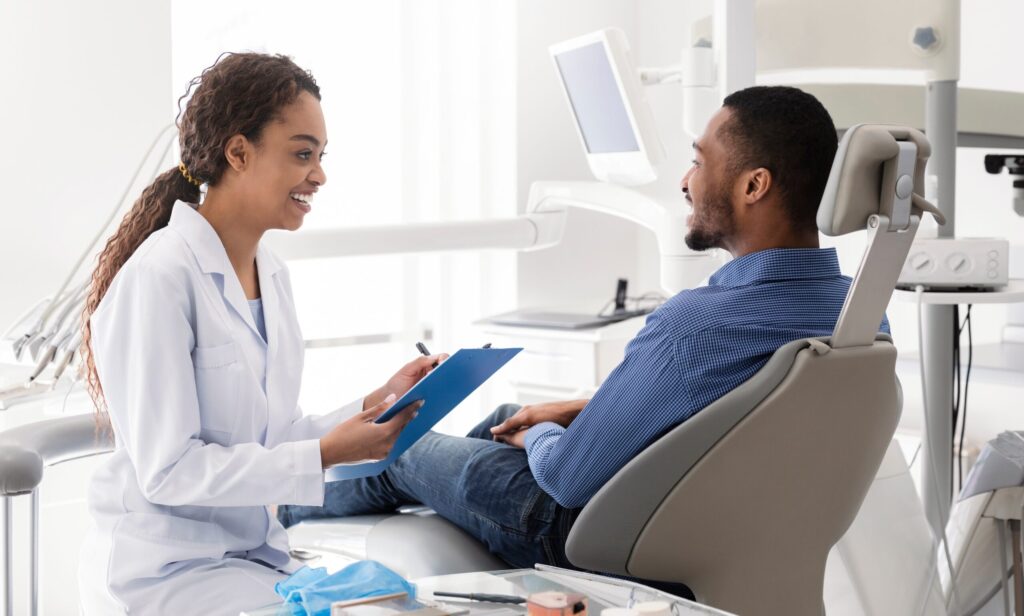Resource Library
Start Reading

What is a dental emergency? A severe toothache is one. A cracked tooth is another.
Knowing what is considered a dental emergency and how to respond can help mitigate pain and prevent long-term damage.
At Penn Dental Family Practice (PDFP), we have the resources and expertise needed for any dental emergency.
 The most comprehensive answer to the question “What is a dental emergency?” is that it is any oral health issue requiring immediate attention to alleviate severe pain, stop bleeding, or save a tooth.
The most comprehensive answer to the question “What is a dental emergency?” is that it is any oral health issue requiring immediate attention to alleviate severe pain, stop bleeding, or save a tooth.
Dental emergencies can arise from accidents (especially sports injuries), infections, or existing dental conditions.
Common examples are:
Other issues like tooth abscesses, where a pocket of pus forms due to infection, or a broken tooth that exposes the nerve also demand urgent dental care. Emergency dentistry provides necessary interventions like tooth extraction or root canal treatment to prevent further complications.
Properly assessing a dental issue is crucial in determining whether it requires immediate attention or can wait for a regularly scheduled dental appointment. Delayed treatment can lead to more extensive damage or even permanent tooth loss.
The first step you should take in any dental emergency is to call your dentist for further instructions. If you aren’t established with a dentist, visit an urgent care center or the nearest emergency room.
Various issues including tooth decay, infection, and gum disease can cause severe toothache pain. You can manage tooth pain immediately by:
If pain persists, consult your dentist as soon as possible. They can identify the pain’s underlying cause and provide proper treatment.
If a tooth is knocked out, you can take immediate actions to increase the chances of saving it:
Treat broken teeth as dental emergencies to prevent further damage or infection.
Promptly seek emergency dental treatment for evaluation of tooth fractures and, when possible, cracked tooth repair.
An abscessed tooth won’t heal on its own. Left untreated, it can spread to your jawbone, your face and neck’s soft tissues of your face and neck, and, in rare cases, even your heart or brain.
Symptoms include severe toothache, sensitivity to hot and cold, swelling, and fever. Often, pus may drain from the tooth or gum, leading to a foul taste in the mouth.
Should you experience these symptoms, seek urgent dental care.
 Understanding what a dental emergency is and what it is not helps you make informed decisions about when to seek care.
Understanding what a dental emergency is and what it is not helps you make informed decisions about when to seek care.
Again, urgent issues often involve severe dental pain, swelling, or a visible dental injury like a broken tooth. In cases like these, arranging an emergency appointment with a dentist is crucial.
On the other hand, nonurgent dental issues might include:
Knowing the urgent vs. nonurgent distinction can help prevent unnecessary emergency visits and ensure resources are available for those who truly need immediate dental care. If in doubt, ask your dentist.
If you face a life-threatening medical emergency, call 911 immediately.
In other situations, you might also need to go immediately to a hospital emergency room.
For example, if you experience uncontrollable bleeding from your mouth, facial injuries involving soft tissues, or traumatic impact that could affect the jawbone or tooth socket, visit an emergency room.
Emergency rooms can handle severe injuries that may require surgical intervention or immediate medical attention beyond emergency dentistry. Additionally, intense, persistent dental pain not relieved by typical pain medications may indicate a need for emergency care at a hospital.
Again, if you experience a dental emergency, contact your dentist. Your dentist is your best ally. Seeking their guidance promptly can lead to better outcomes.
 While some dental emergencies are unavoidable, the right strategies and precautions can help you prevent others.
While some dental emergencies are unavoidable, the right strategies and precautions can help you prevent others.
Wearing a mouthguard when you play sports is one of the most effective ways to prevent dental injuries like cracked teeth and knocked-out teeth. Custom-fitted mouthguards provide the best protection and comfort. Helmets and face shields can further protect the jaw and soft tissues around the mouth.
Regular brushing with fluoride toothpaste and flossing helps keep tooth decay and gum disease at bay, reducing the likelihood of toothache or severe pain.
The best strategy for preventing dental emergencies is setting and sticking to a regular schedule of dental visits.
During routine checkups, dentists can detect signs of tooth decay, tooth abscess, or any fractured teeth before they develop into more severe issues, allowing for timely dental treatment.
We prioritize last-minute appointments for emergency dental care. We offer streamlined, comprehensive, and personalized care to urgent needs. And we help you keep your teeth and gum tissue healthy so you lower your risk of a dental emergency as much as possible.
For more information, download our free eBook, “The Survivor’s Guide to Dental Emergencies.” Knowing how to handle emergencies should they arise is important.
Investing in a good relationship with a dentist is also important. Schedule your next or first appointment at PDFP online now or call us at 215-898-PDFP (7337).